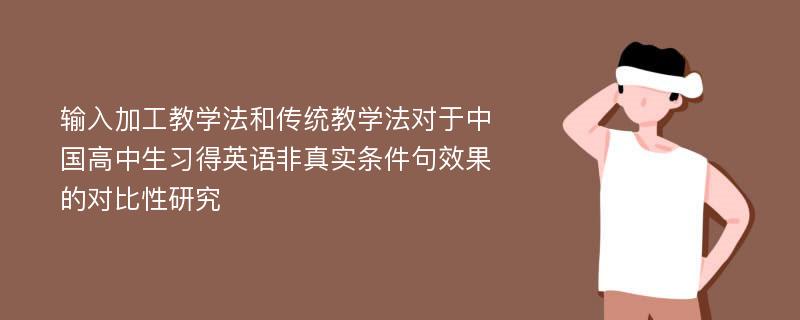
论文摘要
本文对比研究了输入加工教学法和传统教学法对于高中一年级学生在课堂环境中学习非真实条件句的效果。输入加工教学法是VartPatten(1996)基于可理解性输入和注意在输入加工和二语习得发展中的重要作用而提出的。输入加工教学法,以语言输入为特征,目的是通过改变学习者的加工策略来更好地促进语言的吸收和意义-形式的正确连接。而传统的以产出为特征的教学法,包括语言规则的解释和紧随其后的输出性练习。输入和输出在二语习得中的作用一直都是二语习得的理论家和实践者争论的问题之一。本文试图在这一背景下,选取输入加工教学法和传统教学法为代表,对输入和输出的作用进行进一步地研究。共有96名高一年级的中学生参加了为期四周的实验。受试者被随机分为两个实验组和一个控制组。一个实验组用输入加工教学法来教授目标语法结构。而另一个实验组用传统教学法学习同样的内容。控制组的受试者没有接受与目标语法有关的任何教学方法。教学活动开始前的一周,三个组学生参加前测。之后,实验组的学生分别接受各自的教学方法。课堂上的教学过程分两个学时完成。学时结束时,三个组的学生参加即时性后测。两周后,参加延时性后测。三次测试的题型有解释性练习和输出性练习两种。通过对这三次测试中的题型和教学效果持续性的分析,得出以下两个重要结论:第一,输入加工教学法在促进语言理解和语言输出上优于传统教学法。这与VanPatten最初建构的输入加工教学法理论不谋而和,再一次证明了输入在二语习得中起的重要作用。第二,传统教学法不仅能够促进语言输出而且有利于语言理解。这一结果明晰了输出在二语习得的作用,肯定了注意在促进正确的形式和意义连接上的重要作用。
论文目录
Acknowledgements摘要AbstractList of FiguresList of TablesList of AppendixAbbreviationsChapter One INTRODUCTION1.1 Roles of input and output in SLA1.2 Significance of the study1.3 The purpose of the studyChapter Two LITERATURE REVIEW2.0 Overview2.1 The Role of input in SLA2.1.1 Input hypothesis2.1.2 Criticisms on the input hypothesis2.2 The role of consciousness in second language learning2.2.1 Different views on the role of consciousness2.2.2 Noticing hypothesis2.3 Input processing (IP)2.3.1 Input processing2.3.2 Processes of form-meaning connections2.4 Processing instruction (PI)2.5 The role of output in SLA2.5.1 Output Hypothesis2.5.2 An integrated model of SLA in Output Hypothesis2.5.3 One output-based instruction—the traditional instruction (TI)2.6 Comparative studies of PI and TI2.6.1 Empirical studies of PI and TI2.6.2 Limitations of previous researchesChapter Three METHODOLOGY3.0 Overview3.1 Research questions3.2 Subjects3.3 The target structures3.3.1 The Classification of if-conditionals3.3.2 Reasons for selecting the unreal if-conditionals as the target structures3.4 The teaching material3.5 Treatments3.5.1 Traditional instruction3.5.2 Processing instruction3.5.3 Summary3.5.4 The control group3.6 Assessments3.7 Treatment proceduresChapter Four RESULTS4.0 Overview4.1 Results of the interpretation tasks4.2 Results of the production tasks4.3 Results of time effect4.5 Results of the item types4.5.1 Results of the hypothetical unreal if-conditionals4.5.2 Results of the counterfactual unreal if-conditionalsChapter Five DISCUSSIONS5.1 Instructional effects of TI, PI and the control group5.2 Discussion on the results of the processing instruction5.3 Discussion on the results of the traditional instruction5.4 SummaryChapter Six CONCLUSION6.1 Summary of the study6.2 Pedagogical implications6.3 Limitations of the study6.4 Suggestions for further researchReferencesAppendix A: Traditional instruction (1) —Hypothetical unreal conditionalsAppendix B: Traditional Instruction (2) --Counterfactual unreal conditionalsAppendix C: Processing Instruction (1) —Hypothetical unreal conditionalsAppendix D: Processing Instruction (2) —Counterfactual unreal conditionalsAppendix E: PretestAppendix F: Immediate posttestAppendix G: Delayed posttestAppendix H: Raw scores for TI group in the pretestAppendix I: Raw Scores for Tl group in the immediate posttestAppendix J: Raw scores for Tl group in the delayed posttestAppendix K: Raw scores for PI group in the pretestAppendix L: Raw Scores for PI group in the immediate posttestAppendix M: Raw scores for PI group in the delayed posttestAppendix N: Raw scores for the control group in the pretestAppendix O: Raw scores for the control group in the immediate posttestAppendix P: Raw scores for the control group in the delayed posttest
相关论文文献
- [1].基于PBL教学法的案例设计研究[J]. 鸭绿江(下半月版) 2014(09)
- [2].项目教学法在高职教学应用中的几点思考[J]. 益阳职业技术学院学报 2018(01)
- [3].视频反馈教学法在气管插管教学中的作用[J]. 中国高等医学教育 2019(10)
- [4].基于辩论教学法在临床药理学课程中的应用提升学生科学素养和创新实践能力的探析[J]. 教育现代化 2019(91)
- [5].教学改革的核心应当是“思维的改革”——以“教学法导论”课为例[J]. 教育现代化 2019(86)
- [6].项目教学法的理论与实践研究[J]. 当代教育实践与教学研究 2019(24)
- [7].基于积极教学法的大学物理实验教学改革与实践[J]. 物理实验 2020(01)
- [8].五步教学法在专创融合课程改革中的探索与实践[J]. 西部皮革 2019(24)
- [9].项目教学法在编程实训课中的应用研究[J]. 产业与科技论坛 2019(22)
- [10].项目教学法在《土力学》课程中的实践研究[J]. 教育教学论坛 2020(04)
- [11].项目教学法在高职实验教学中的应用研究[J]. 科技风 2020(05)
- [12].基于项目教学法在汽车电器课程教学中的应用[J]. 电脑知识与技术 2020(05)
- [13].服务学习教学法的一次行动探索[J]. 教育学术月刊 2020(01)
- [14].浅谈分组式教学法是如何提高学生“抬头率”的[J]. 重庆工贸职业技术学院学报 2019(04)
- [15].工作室教学法在西方高等教育领域的应用研究[J]. 设计 2020(01)
- [16].混合型教学法在临床生物化学检验理论教学中的应用[J]. 中国高等医学教育 2020(01)
- [17].以问题为基础的教学法和以病例为基础的教学法在肿瘤外科学临床教学中的应用进展[J]. 肿瘤基础与临床 2019(06)
- [18].在旅游酒店管理教学中项目教学法的运用研究[J]. 旅游纵览(下半月) 2020(04)
- [19].基于云班课的高职院校混合式教学法[J]. 濮阳职业技术学院学报 2020(02)
- [20].项目教学法在中职电子课程教学中的应用[J]. 内江科技 2020(04)
- [21].论以就业为导向的数控实训教学中的项目教学法[J]. 湖北农机化 2020(02)
- [22].项目教学法在高校工作室的应用分析[J]. 大众标准化 2020(04)
- [23].项目教学法在高职展示设计课程中的应用[J]. 科教导刊(下旬) 2020(01)
- [24].“问题链教学法”在《概论》课教学中的应用研究及设计[J]. 现代商贸工业 2020(15)
- [25].积极教学法与职教理念相融的可行性分析及实践[J]. 西部素质教育 2020(07)
- [26].项目教学法在电气教学的应用研究[J]. 科技资讯 2020(07)
- [27].项目教学法在电气焊教学中的运用[J]. 科技经济导刊 2020(09)
- [28].浅析建筑识图与构造课程中项目教学法的应用[J]. 现代物业(中旬刊) 2019(10)
- [29].项目教学法在汽车底盘教学中的运用[J]. 佳木斯职业学院学报 2020(06)
- [30].项目教学法在影视教学中的运用研究[J]. 农家参谋 2020(12)
标签:输入加工教学法论文; 传统教学法论文; 输入论文; 输出论文; 非真实条件句论文;
输入加工教学法和传统教学法对于中国高中生习得英语非真实条件句效果的对比性研究
下载Doc文档
